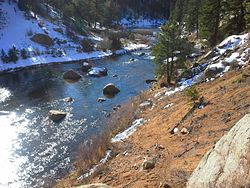South Platte River
This article needs additional citations for verification. (January 2011) |
| South Platte River[1] | |
|---|---|
 South Platte River in Douglas County, Colorado | |
 | |
| Native name | Wašíŋ Wakpá (Lakota) |
| Physical characteristics | |
| Source | |
| • location | Confluence of South Fork and Middle Fork |
| • coordinates | 39°00′40″N 105°44′25″W / 39.01111°N 105.74028°W |
| Mouth | |
• location | Confluence with North Platte River |
• coordinates | 41°06′50″N 100°40′33″W / 41.11389°N 100.67583°W |
• elevation | 2,762 ft (842 m) |
| Length | 439 mi (707 km)[2] |
| Discharge | |
| • average | 174 cu ft/s (4.9 m3/s) |
| Basin features | |
| Progression | Platte—Missouri—Mississippi |
| Discharge range | 0 to 4,640 cu ft/s (0 to 131 m3/s)[3] |


The South Platte River is one of the two principal
Description
The river is formed in
The river flows north through central Denver, which was founded along its banks at its confluence with
East of Greeley, it turns eastward, flowing across the
The South Platte River through Denver is on the U.S.
The flows of the South Platte have been greatly modified by human activity. Originally the river was seasonal north of Fort Morgan to its confluence with the North Platte. In the 1800s the river would disappear in July, August, and September due to low flows and a sandy river bottom. By 1910 the increase in agriculture caused the river to reach the border of Colorado and Wyoming due to return flows and dams holding back water later in the year. Increasing diversions from the upper Colorado River in the 20th century mean that flows reach the North Platte year round.[4]
History
The South Platte was originally called Niinéniiniicíihéhe by the native Arapaho people who lived on its banks. The early Spanish explorers called it the Rio Chato (calm river). In 1702, it was named the Rio Jesus Maria by Captain Jose Naranjo, the Indigenous-Spanish scout and captain of war of the New Mexico Indian Auxiliaries, who was ordered by the viceroy of New Spain to search the Tierra Incognita for a French incursion into New Mexico.[5] The South Platte also served as a vital water source in Colorado. Long before the city of Denver was created, many travelers came to the South Platte River to escape the arid Great Plains. These people could survive the heat, but not without the vital water source that the South Platte gave them. Buckets and wells sufficed as a water system for a while, but eventually, the Denver Water System was created.[6]
Dams
In an arid region of the United States, the South Platte is marked with several dams. The first notable water impoundment on the South Platte is Antero Reservoir. "Antero" is derived from the Spanish word "delantero", which means "foremost" or "head", as the reservoir was the first dam on the South Platte River near the river's origin.
The next dam is Spinney Mountain Reservoir. At capacity, Spinney Mountain covers 2,500 acres (10 km2). A bottom-release dam, Spinney releases to the east of the inlet.
Two miles below Spinney Mountain Reservoir, the river enters Eleven Mile Reservoir, with a capacity of 97,000 acre-feet (120,000,000 m3). The Eleven Mile Reservoir Dam drains into Eleven Mile Canyon, which runs through Forest Service land. Three former Colorado towns, Howbert, Idlewild, and Freshwater Station, were submerged under the reservoir when it was built.[7]
From
In the late 1980s, a proposal was put forth for the Two Forks Dam, which would have created a reservoir flooding the entire section from the North Fork confluence to the town of Deckers. In 1990, the US EPA vetoed the permit, calling the project an "environmental catastrophe."
From the confluence, the river flows towards Denver and enters Strontia Springs Reservoir.
Below Strontia Springs, the South Platte runs through
Fly fishing overview
The South Platte River is a gold medal western trout river on the eastern slope of Colorado, meaning it produces at least 12 trout of greater than 14 inches in length or greater per acre in areas accessible to the public. The river is well known for its wild trophy population of
See also
- List of rivers of Colorado
- List of rivers of Nebraska
- South Platte River Trail Scenic and Historic Byway, a 19-mile byway in Sedgwick County, Colorado
- South Platte Trail, the historic trail along the South Platte River, from northwestern Colorado to the Denver area
References
- ^ "South Platte River". Geographic Names Information System. United States Geological Survey, United States Department of the Interior. Retrieved 2011-01-29.
- ^ U.S. Geological Survey. National Hydrography Dataset high-resolution flowline data. The National Map, accessed March 25, 2011
- ^ Water Data Report, Colorado 2003, from Water Resources Data Colorado Water Year 2003, USGS.
- ISBN 978-0-309-04528-5. Retrieved 28 May 2024.
- Nebraska State Historical Society. p. 46.
- ^ Denver Water History Archived 2016-09-03 at the Wayback Machine. Accessed June 23, 2014.
- ISBN 978-1-62619-161-7, pp. 97-104.
- ^ "Colorado Gold Waters". Colorado Gold Medal Waters. Trout Unlimited. Retrieved 28 May 2024.
External links
- Antero Reservoir
- Chatfield Reservoir
- Cheesman Reservoir
- USGS: South Platte River Basin
- University of Colorado: GIS Hydro Data for the South Platte
- City of Denver: South Platte Initiative
- Eleven Mile Reservoir
- The Greenway Foundation
- Spinney Mountain Reservoir
- Strontia Springs Reservoir and Waterton Canyon
